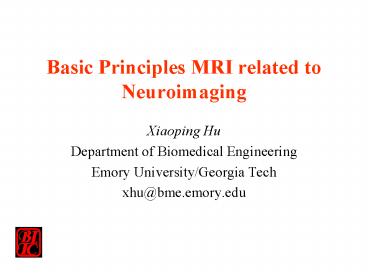Basic Principles MRI related to Neuroimaging - PowerPoint PPT Presentation
1 / 52
Title:
Basic Principles MRI related to Neuroimaging
Description:
Basic Principles MRI related to Neuroimaging Xiaoping Hu Department of Biomedical Engineering Emory University/Georgia Tech xhu_at_bme.emory.edu Outline Basic NMR/MRI ... – PowerPoint PPT presentation
Number of Views:935
Avg rating:3.0/5.0
Title: Basic Principles MRI related to Neuroimaging
1
Basic Principles MRI related to Neuroimaging
- Xiaoping Hu
- Department of Biomedical Engineering
- Emory University/Georgia Tech
- xhu_at_bme.emory.edu
2
Outline
- Basic NMR/MRI Physics
- Imaging sequences
- Contrast Mechanisms
- Pitfalls and Limitations
3
In the absence of magnetic field
4
In the presence of magnetic field
5
Bulk Nuclear Magnetization in the Presence of a
Static Magnetic Field
6
Precession
nuclear spin inside a magnetic field
7
Larmor Frequency
? is frequency of precession and
resonance usually in the radiofrequency (RF) range
8
Resonance
Resonance occurs when the external influence
exerted to a system matches the systems natural
frequency. E.g., pushing a swing In MRI, the
natural frequency, called the Larmor frequency,
is proportional to the applied magnetic field. At
1.5 T, it is 64 Mhz (1Mhz1000,000 hz FM radio
uses 88-106 Mhz).
9
Generation of NMR signal
- Excitation
- an RF pulse is applied to tip the magnetization
such that it has a transverse component - Reception
- precessing transverse component of M induces an
emf in a receiving RF coil - Relaxation
- The processes with which the magnetization
returns to equilibrium. They determine the
intensity/contrast of the image
10
Spatial discriminationachieved with magnetic
field gradients
B0
x
11
Selective Excitation Application of a
band-limited RF pulse in the presence of a
gradient along the direction perpendicular to the
desired slice
B0
w
RF power
12
Lauterbur, 242, 190, Nature, 1973.
13
w
B0
14
phase
frequency
15
FT
16
RF
Gss
Gpe
Gro
Signal
timing diagram of a spin-echo sequence
17
frequency encoding
phase encoding
k-space traversal of a spin-echo sequence
18
Temporally interleaved multislice imaging
slice 1 acquisition
slice 2 acquisition
slice n acquisition
TR
19
Effects of Slice Spacing and Order
nominal thickness
with gap or skip
no interleave
1
2
7
8
9
10
11
12
3
4
5
6
interleave
1
7
4
10
5
11
6
12
2
8
3
9
20
timing diagram of a blipped EPI sequence
RF
Gss
Gpe
Gro
Signal
21
frequency encoding
phase encoding
k-space traversal of an EPI sequence
22
Spiral Pulse Sequence
23
Spiral k-space trajectory
i?(t)
k k(t) e k(t) C t ?(t) C k(t)
(Archimedian)
1
2
24
CONTRAST MECHANISMS in MRI T1 (Spin-lattice
Relaxation time) relaxation along Bo T2
(Spin-spin relaxation time) relaxation
perpendicular to Bo T2 (Signal decay
perpendicular to Bo ) due to dephasing plus T2
25
Relaxation and Contrast
z
T1-relaxation
y
T2-relaxation
x
26
T1 relaxation
TR
90 pulse
90 pulse
M0
M
TR
27
Signal decay due to transverse relaxation
Irreversible processes (T2) Dephasing due to
different frequency of precession in the
presence of magnetic field inhomogeneities
(reversible) (T2).
1/T21/ T2 1/T2 Characterizes decay due to
both processes.
28
TE
180 pulse
90 pulse
29
90 pulse
time
-TE/T2
S(TE) So e
30
Relaxation and Contrast
T1-relaxation Growth of magnetization for next
nutation
T2-relaxation decay of magnetization being
detected
31
T1w Imaging at 3 Tesla
32
Brain Tumor Imaging
T2W Pre-contrast
T1W Pre-contrast
T1W Post-contrast
MRI for brain tumor
33
Spatial resolution
- Signal-to-noise ratio
- Imaging time
- Gradient performance parameters
- Physics
- Diffusion
- Signal decay
34
State of the Art
- Structural imaging of human subjects
- 1mm 1mm 1mm
- Anatomic imaging of rodents
- 50?m 50 ?m 50 ?m
- NMR microscopy (of samples)
- 10?m 10 ?m 10 ?m
- Functional studies
- Humans 3mm 3mm 5mm
- Animals 100?m 100 ?m 500 ?m
- In vivo proton spectroscopy
- Human 7mm 7mm 7mm
- Animal 1mm 1mm 1mm
35
Temporal resolution
- Signal-to-noise ratio
- Image resolution
- Gradient performance parameters
- Physics
- Relaxation
36
State of the Art
- High resolution 3-D structural imaging
- 10-20 min
- Multislice imaging
- minutes
- Anatomic imaging of animals
- hours
- NMR microscopy (of samples)
- hours to days
- Functional studies
- Sec/image, minutes/study
- In vivo proton spectroscopy
- Human 10s of minutes
- Animal hours
37
High-resolution imaging with reduced FOV Zoomed
imaging by outer volume saturation
38
Limitations of ultrafast sequences
- EPI
- Nyquist ghost
- Spatial distortion
- Spiral
- Blurring
- EPI and Spiral
- Signal dropout
- Resolution degradation due to T2 decay
39
Nyquist ghost
k-space data
image
40
image
k-space data
41
B0 inhomogeneity induced distortion
- Several possible causes
- Static field inhomogeneity
- Subject-dependent susceptibility
- Field inhomogeneity disturbs the conditions of
Fourier imaging - Image distortion and artifacts are encountered
with severe inhomogeneity
42
EPI image distortion due to field inhomogeneity
43
Phase map
original
corrected
flash
Single-Shot EPI
Segmented EPI
44
Spiral (before correction)
45
Spiral (after correction)
46
Problems in both EPI and Spiral
- signal loss due to T2 decay
- resolution degraded and limited by T2
47
(No Transcript)
48
7 Tesla T2-weighted images (TE 15 msec)
5-mm
? 1-mm
z-shim
49
Pulse Sequence for a Single-Shot EPI with
Susceptibility Compensation
Song, MRM 46, 407, 2001.
50
Combined images from the single-shot
acquisitioncompared with conventional
single-shot acquisition at 4T
Song, MRM 46, 407, 2001.
51
Spiral-In/Out Experiments
TE
Acquisitions - spiral-out (A)
- spiral-in (B) - combined
spiral-in/out (C)
Glover Law, MRM, 45, 515, 2001
52
Spiral-In/Out Combination
spiral-out
S
spiral-in
wtd ave
Glover Law, MRM, 45, 515, 2001































